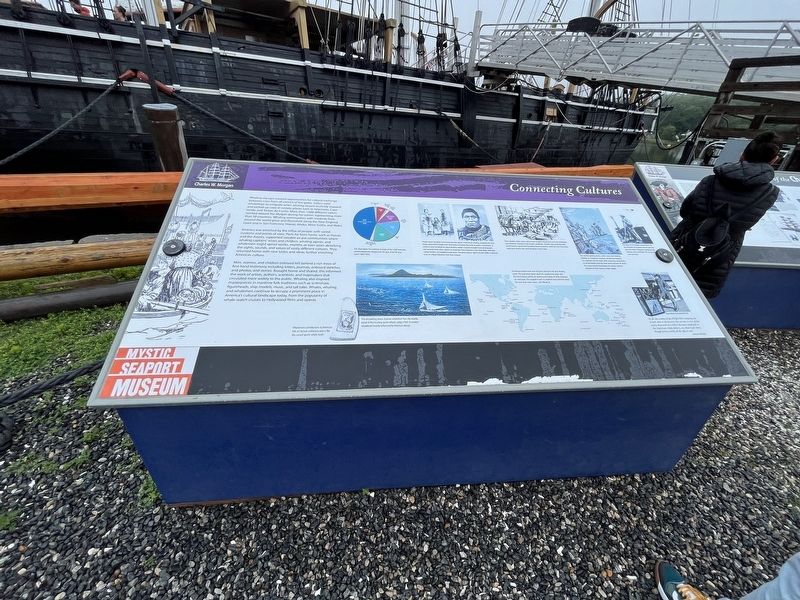Mystic in Stonington in New London County, Connecticut — The American Northeast (New England)
Connecting Cultures
Charles W. Morgan
— Mystic Seaport Museum —
Whaling voyages created opportunities for cultural exchange between crew from all corners of the globe. Sailors used whaleships to emigrate when whaling vessels routinely stopped and picked up crew in remote places such as Valparaiso, Cape Verde, and Tristan de Cunha. More than 1,600 different sailors worked aboard the Morgan during her career, representing more than 50 countries. Whaling communities with residents from around the world grew and flourished along the New England coast and in San Francisco, Hawaii, Alaska, Nova Scotia, and Wales.
America was enriched by the influx of people with varied customs and points of view. Ports far from home, such as Hawaii and the Azores, supported sizeable expat communities where whaling captains' wives and children, whaling agents, and whalemen might spend weeks, months, or even years absorbing the sights, sounds, and values of vastly different cultures. They returned home with new tastes and ideas, further enriching American culture.
Men, women, and children onboard left behind a rich trove of first-hand testimony including letters, journals, onboard sketches and photos, and stories. Brought home and shared, this informed the work of artists, authors, scientists, and mapmakers that circulated more widely to the public. Whaling also inspired masterpieces in maritime folk traditions such as scrimshaw, figureheads, ship models, music, and tall tales. Whales, whaling, and whalemen continue to occupy a prominent place in America's cultural landscape today, from the popularity of whale-watch cruises to Hollywood films and operas.
[Captions:]
This chart shows the countries of origin of the 1,600 men who served onboard the Morgan over the span of her 80-year career (1841-1921).
Western Islands 1%
Azores Islands 2%
Cape Verde Islands 11%
South America 2%
Guam 13%
Japan 1%
Europe 15%
Australia & New Zealand 2%
USA (including Hawaii & Alaska) 44%
West Indies 2%
Other 7%
People across the globe were drawn into the sphere of American whaling, including this Inuit family (above left) brought from their home in Hudson Bay to New London, Connecticut, to testify in court on behalf of a local whaling captain. Captains brought home photographs and souvenirs from other cultures to remember their experiences and share them with their curious families and neighbors back home. This photo (above right) from the 1880s is believed to be of a Maori tribesman from New Zealand.
These drunken sailors ashore attest to the negative impact that American whaleships and whalemen sometimes had on ports worldwide. Wooden ships unintentionally carried invasive species that threatened local ecosystems, while the men themselves could leave disease and social disruption in their wake.
This colorful painting shows a multi-racial crew working together in a dangerous situation, precariously standing on a platform over the water while using long, sharp blades to cut the blubber from the dead whale and fend off sharks. On a lucky ship like the Morgan, this process could be repeated 60 times during a single voyage.
The name of this Morgan crewmember was not recorded on the photo, but he may have been one of the Portuguese-speaking Cape Verdeans who constitute 11% of the ship's crew over time.
Whalemen's contributions to American folk art include scrimshaw pieces like this carved sperm-whale tooth.
This oil painting shows Azorean whalemen from the nearby island of Pico hunting sperm whales using a fleet of wooden whaleboats heavily influenced by American design.
The Morgan visited more than 100 ports during her 80-year whaling career. The map shows about 40, ranging from large cities like San Francisco and Rio de Janeiro to the islands of Tahiti, Madagascar, and Guam. She stopped in ports to replenish food and fresh water, hire new crew, make repairs, and offload oil.
"As for the residue of the Pequod's company, be it said, that at the present day not one in two of the many thousand men before the mast employed in the American whale fishery, are Americans born, though pretty near the officers are."
- Herman Melville
Erected by Mystic Seaport Museum.
Topics. This historical marker is listed in these topic lists: Anthropology & Archaeology • Arts, Letters, Music • Industry & Commerce • Waterways & Vessels.
Location. 41° 21.735′ N, 71° 57.897′ W. Marker is in Stonington, Connecticut, in New London County. It is in Mystic. Marker can be reached from Greenmanville Avenue (Connecticut Route 27) south of Hinckley Street, on the left when traveling north. Touch for map. Marker is at or near this postal address: 75 Greenmanville Avenue, Mystic CT 06355, United States of America. Touch for directions.
Other nearby markers. At least 8 other markers are within walking distance of this marker. Whaleship Charles W. Morgan (here, next to this marker); Fishing Schooner L.A. Dunton (here, next to this marker); Changing Perceptions of the Natural World (here, next to this marker); The History of the Charles W. Morgan (here, next to this marker); Perils and Profits (a few steps from this marker); Whaleboat (within shouting distance of this marker); Whale Ship Charles W. Morgan (within shouting distance of this marker); Cape Cod Catboat Breck Marshall (within shouting distance of this marker). Touch for a list and map of all markers in Stonington.
Credits. This page was last revised on June 28, 2023. It was originally submitted on June 28, 2023, by Devry Becker Jones of Washington, District of Columbia. This page has been viewed 51 times since then and 9 times this year. Photo 1. submitted on June 28, 2023, by Devry Becker Jones of Washington, District of Columbia.
Editor’s want-list for this marker. A wide shot of the marker in context. • Can you help?
